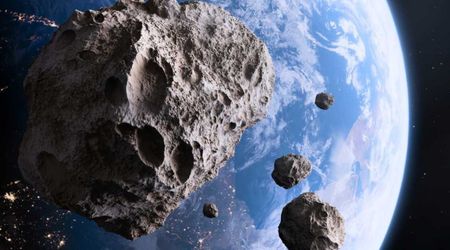Which Planet Has The Strongest Gravity Field?


Discover the incredible power of gravity as we uncover the strongest gravitational force in our solar system. From massive gas giants to rocky terrestrials, each planet holds its own unique gravitational pull. But which one reigns supreme?
In the solar system, Jupiter is the planet with the strongest gravity field. Why is that? And how does gravity work?
Understanding gravity
Bronze Age to Classical Antiquity
Early scientific ideas about gravity were based on observations of how things naturally fell toward the ground and planetary motion. From ancient times most of humanity believed Earth was the center of the universe.
Ancient Babylonians predicted eclipses and the movements of the planets. Greek philosopher Aristotle (384-322 BCE) described the Sun, planets and stars moving in circular orbits around Earth and heavier objects falling faster than lighter ones.
Greek mathematician and astronomer Ptolemy (100-170 CE), devised a complex system of eccentric circles with epicycles to describe the geocentric (Earth-centered) universe and retrograde motion of the other planets.
Early Modern Period
Key discoveries in humanity’s understanding of gravity were made centuries later. Famous astronomer, mathematician and father of modern astronomy, Nicolaus Copernicus (1473-1543) wrote an astronomical treatise describing a heliocentric (Sun-centered) universe in which the planets were correctly ordered from the Sun and their orbital periods estimated. Copernicus also described Earth rotating on it’s axis and gradual shifts in that axis accounting for seasons. Copernicus delayed publication of this work until 1543 because it didn’t explain why objects fell to the ground or why the planets didn’t have perfectly circular orbits.
Italian astronomer Galileo Galilei (1564-1642) deduced that everything on Earth falls at exactly the same rate. This rate is called acceleration due to gravity (g) and is nearly constant at every location on Earth. Gravity is an attractive pulling force that can work over long distances. Think of Earth’s gravity as originating at a pinpoint at the centre of Earth and pulling everything toward that point. The amount of gravity felt at any location on Earth varies according to the distance from the origin. There is slightly more gravity at sealevel than on a mountain top and at the poles than at the equator due to the Earth’s oblate spheroid shape.
Danish astronomer Tycho Brahe (1546-1601) made the most accurate celestial observations of his time. Brahe’s new model of the universe placed the Moon and Sun in orbit around Earth (geocentric) and the other planets in orbit around the Sun (heliocentric). German astronomer Johannes Kepler (1571-1630) used Brahe’s observations to analyze the orbit of Mars and deduce three laws of planetary motion. Kepler’s Three Laws were published in 1609 and state that 1) planets move in ellipses with the Sun at one focus, 2) their radius vectors describe equal areas in equal times and 3) squares of their periodic times are proportional to the cubes of their mean distances.
Sir Isaac Newton (1642-1727) realized that the force of gravity that makes things fall to Earth is the exactly the same as the force of gravitation that keeps the planets spinning in their orbits in space. In 1687 Newton published the universal law of gravitation. Newton’s Law describes gravity as an invisible force that pulls objects toward the center of each other. The force of gravity (F) between two masses (M and m) separated by a distance (r) is F= G M m / r2 where G = the universal gravitational constant = 6.67 x 10-11 Nm2/kg2. Like many other constants in physics equations, G is a fixed number that makes sure the equations work. In 1798 Henry Cavendish (1731-1810) calculated G by measuring the force between two lead spheres of known mass a known distance apart.
Newton’s Law applies to every mass in the universe and any two masses have a mutual force. This means the Earth pulls you down with the same force that you pull the Earth up. The larger the masses, the more force between them and the closer the masses are to each other, the larger the force of gravity is between them. The force of gravity is inversely proportional to the distance between the masses so doubling the distance, reduces the force of gravity by one quarter.

Masses & Weight in our Solar System
The Sun has a mass of 1.989 x 1030 kilograms and contributes 99.8% of the mass in our solar system. Its gravity holds the solar system together. Similarly, Jupiter’s gravity holds its moons in orbit around it and Earth’s gravity holds the Moon in orbit around it.
A planet’s mass dictates the amount of gravity it will produce. In decreasing order, the planets have the following masses:
Planetary Masses In Decreasing Order | |||
Rank | Planet | Mass (1024 kg) | Mass (x1021 tons) |
1 | Jupiter | 1898 | 2092 |
2 | Saturn | 568 | 626 |
3 | Neptune | 102 | 113 |
4 | Uranus | 86.8 | 95.7 |
5 | Earth | 5.97 | 6.58 |
6 | Venus | 4.87 | 5.37 |
7 | Mars | 0.642 | 0.707 |
8 | Mercury | 0.33 | 0.364 |
Gravity is calculated as the gravitational acceleration on a rocky planet’s surface at the equator and at 1 bar pressure level in the atmosphere for gas giants.
Planetary Gravity In Decreasing Order | |||
Rank | Planet | Gravity (m/s2 kg) | Gravity (ft/s2) |
1 | Jupiter | 23.1 | 75.9 |
2 | Neptune | 11.0 | 36.0 |
3 | Earth | 9.8 | 32.1 |
4 | Saturn | 9.0 | 29.4 |
5 | Venus | 8.9 | 29.1 |
6 | Uranus | 8.7 | 28.5 |
7 | Mars | 3.7 | 12.1 |
8 | Mercury | 3.7 | 12.1 |
The force of gravity that acts on an object is known as an object’s weight. The weight (W) of an object on Earth with mass (m) is W= m * g where g=Earth’s acceleration due to gravity = 9.8 m/s2.
If we know the weight of an object on Earth we can calculate the weight of that object on another planet The weight of an object on planet X is Wx= We * gr where We= the weight of the object on Earth and gr= ratio of planet X’s gravity to Earth’s gravity.
Gravity Ratio In Decreasing Order & Example Masses | ||||
Rank | Planet | Gravity ratio | Weight on Planet (kg) | Weight on Planet (pounds) |
1 | Jupiter | 2.36 | 118 | 236 |
2 | Neptune | 1.12 | 56 | 112 |
3 | Earth | 1 | 50 | 100 |
4 | Saturn | 0.916 | 45.8 | 91.6 |
5 | Venus | 0.907 | 45.3 | 90.7 |
6 | Uranus | 0.889 | 44.4 | 88.9 |
7 | Mercury | 0.378 | 18.9 | 37.8 |
8 | Mars | 0.377 | 18.8 | 37.7 |
Long Nineteenth Century
Newton’s Law doesn’t explain what caused gravity or how it passes from one side of the universe to the other. In 1905, German mathematician and physicist, Albert Einstein (1879-1955) published his Theory of Special Relativity, in which energy =mass * c2, where c=speed of light in a vacuum=3.0x108 m/s.
In 1915, Einstein published his General Theory of Relativity which included gravity. A key concept of this theory is the principle of equivalence: the force produced by gravity is exactly the same as the force produced by acceleration. This means gravity is the curvature of spacetime around mass or energy.
In 1919, British astronomers Frank Watson Dyson (1868-1939) and Arthur Eddington (1882-1944) confirmed this when they observed light rays being distorted during a solar eclipse. Einstein predicted that when large masses are disturbed they will send out gravitational waves. In 2015, gravitational waves were detected for the first time by scientists in the United States.

Jupiter’s Gravitational Influence
Jupiter's gravity affects objects that don’t orbit it. It pulls asteroids and comets toward Jupiter. These objects may have their orbits altered from circular to elliptical, they may be pulled into Jupiter or put on a collision course with one of the inner planets. Long-period comets may be flung out of the solar system. Jupiter's gravity prevented the asteroid belt between Mars and Jupiter from forming a planet when our solar system was young.









